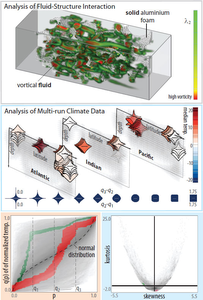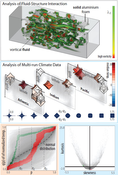Information
- Visibility: hidden
- Publication Type: PhD-Thesis
- Workgroup(s)/Project(s): not specified
- Date: March 2011
- Date (Start): December 2007
- Date (End): March 2011
- TU Wien Library:
- Second Supervisor: Eduard Gröller
- 1st Reviewer: Prof. Heidrun Schumann
- 2nd Reviewer: Prof. Min Chen
- Rigorosum: May 27, 2011
- First Supervisor: Helwig Hauser
Abstract
Visualization plays an important role in exploring, analyzing and presenting large and heterogeneous scientific data that arise in many disciplines of medicine, research, engineering, and others. We can see that model and data scenarios are becoming increasingly multi-faceted: data are often multi-variate and time-dependent, they stem from different data sources (multi-modal data), from multiple simulation runs (multi-run data), or from multi-physics simulations of interacting phenomena that consist of coupled simulation models (multi-model data). The different data characteristics result in special challenges for visualization research and interactive visual analysis. The data are usually large and come on various types of grids with different resolution that need to be fused in the visual analysis.This thesis deals with different aspects of the interactive visual analysis of multi-faceted scientific data. The main contributions of this thesis are: 1) a number of novel approaches and strategies for the interactive visual analysis of multi-run data; 2) a concept that enables the feature-based visual analysis across an interface between interrelated parts of heterogeneous scientific data (including data from multi-run and multi-physics simulations); 3) a model for visual analysis that is based on the computation of traditional and robust estimates of statistical moments from higher-dimensional multi-run data; 4) procedures for visual exploration of time-dependent climate data that support the rapid generation of promising hypotheses, which are subsequently evaluated with statistics; and 5) structured design guidelines for glyph-based 3D visualization of multi-variate data together with a novel glyph. All these approaches are incorporated in a single framework for interactive visual analysis that uses powerful concepts such as coordinated multiple views, feature specification via brushing, and focus+context visualization. Especially the data derivation mechanism of the framework has proven to be very useful for analyzing different aspects of the data at different stages of the visual analysis. The proposed concepts and methods are demonstrated in a number of case studies that are based on multi-run climate data and data from a multi-physics simulation.
Additional Files and Images
Weblinks
No further information available.BibTeX
@phdthesis{Kehrer-2011-PhD,
title = "Interactive Visual Analysis of Multi-faceted Scientific Data",
author = "Johannes Kehrer",
year = "2011",
abstract = "Visualization plays an important role in exploring,
analyzing and presenting large and heterogeneous scientific
data that arise in many disciplines of medicine, research,
engineering, and others. We can see that model and data
scenarios are becoming increasingly multi-faceted: data are
often multi-variate and time-dependent, they stem from
different data sources (multi-modal data), from multiple
simulation runs (multi-run data), or from multi-physics
simulations of interacting phenomena that consist of coupled
simulation models (multi-model data). The different data
characteristics result in special challenges for
visualization research and interactive visual analysis. The
data are usually large and come on various types of grids
with different resolution that need to be fused in the
visual analysis. This thesis deals with different aspects
of the interactive visual analysis of multi-faceted
scientific data. The main contributions of this thesis are:
1) a number of novel approaches and strategies for the
interactive visual analysis of multi-run data; 2) a concept
that enables the feature-based visual analysis across an
interface between interrelated parts of heterogeneous
scientific data (including data from multi-run and
multi-physics simulations); 3) a model for visual analysis
that is based on the computation of traditional and robust
estimates of statistical moments from higher-dimensional
multi-run data; 4) procedures for visual exploration of
time-dependent climate data that support the rapid
generation of promising hypotheses, which are subsequently
evaluated with statistics; and 5) structured design
guidelines for glyph-based 3D visualization of multi-variate
data together with a novel glyph. All these approaches are
incorporated in a single framework for interactive visual
analysis that uses powerful concepts such as coordinated
multiple views, feature specification via brushing, and
focus+context visualization. Especially the data derivation
mechanism of the framework has proven to be very useful for
analyzing different aspects of the data at different stages
of the visual analysis. The proposed concepts and methods
are demonstrated in a number of case studies that are based
on multi-run climate data and data from a multi-physics
simulation.",
month = mar,
address = "Favoritenstrasse 9-11/E193-02, A-1040 Vienna, Austria",
school = "Institute of Computer Graphics and Algorithms, Vienna
University of Technology ",
URL = "https://www.cg.tuwien.ac.at/research/publications/2011/Kehrer-2011-PhD/",
}


 Slides
Slides Thesis
Thesis

